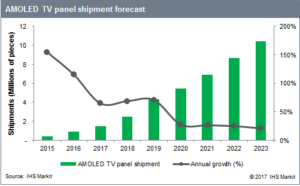According to IHS Markit, AMOLED TV panel shipments will exceed 10 million units by 2023. As panel makers are increasingly targeting the premium TV market, AMOLED TV panel shipments are growing at a compound annual growth rate of 42% from 2017. IHS Markit believes that the high manufacturing cost of AMOLED TV panels will remain a hurdle to a greater shipment increase.
Panel manufacturers are continuously increasing AMOLED TV panel line-ups with differentiated picture quality targeting the premium TV market. LG Display is the only AMOLED TV panel supplier and is continuously increasing UHD AMOLED TV panel shipments, while planning to discontinue the mass production of full HD AMOLED TV panels this year.
According to Jerry Kang, principal analyst at IHS Markit, most TV brands recognise that AMOLED TV will be more competitive in the premium TV market, which is less price-sensitive than even the high-end TV market, considering the relatively high manufacturing cost of AMOLED TV panels.
Kang also predicted that 65” UHD TV panels will account for 48% of the total AMOLED TV panel shipments in 2017, and that most of AMOLED panel manufacturers are trying to develop an ink-jet AMOLED process, as this is seen as a viable way to reduce manufacturing costs. However, they are facing challenges with the soluble emitting materials used in the process, resulting in low-performance yields.
Kang went on to say that the panel manufactures are now associating themselves with a few equipment and material suppliers to develop and optimise the ink-jet AMOLED process, with an aim to mass produce AMOLED TV panels using ink-jet printing within two years.
AMOLED TV panel shipments forecast by IHS Markit
Analyst Comment
Kateeva said at SID last year that it is confident about making inkjet technology feasible for mass production. Kateeva has been doing well in selling its inkjet technology to help makers with the tricky job of OLED encapsulation, so has real credibility in the industry. We’re looking forward to getting an update on this next week in Los Angeles. Ken wrote a Display Daily in which he wondered whether OLED may come under threat from Samsung’s Quantum Dot LCDs over the next couple of years, partly because of the higher peak brightness and partly because of the better colour volume. (This is War!) (BR)

